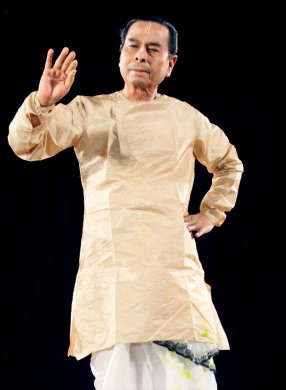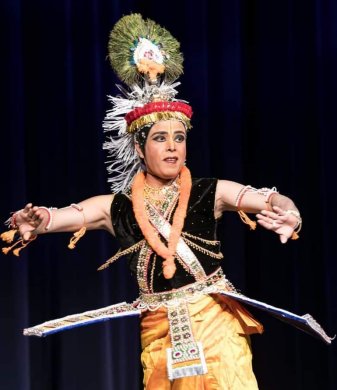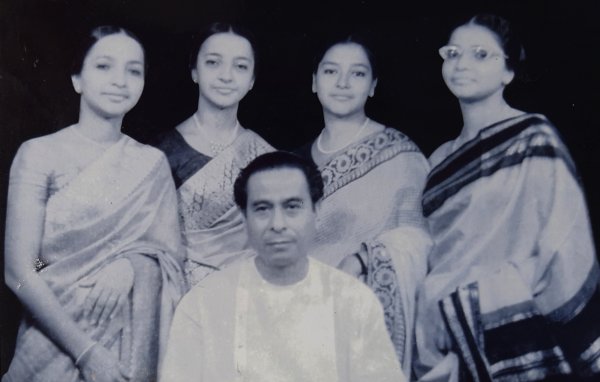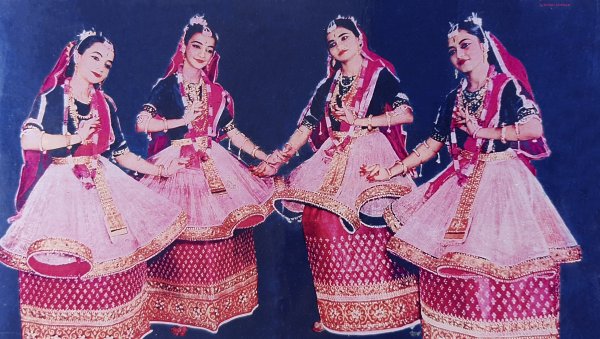
|   |

|   |
 e-mail: ukb7@rediffmail.com Bipin Singh: A lodestar in dancers' constellation Photos & video courtesy: Darshana Jhaveri June 27, 2021  Guru Bipin Singh Guru Bipin Singh (1918 – 2000), a director, choreographer and scholar of Manipuri dance, is regarded as Father of Manipuri style for more reasons than one. First, he displayed an early flair for ordinal skill (i.e., naming the elements he could identify in the traditions of Lai Haraoba as well as Nata Sankirtan and the seven Ras Leelas that could be amalgamated in the emerging Manipuri form); ordinal skill (i.e., deciding relative importance to be attached to each element); and interval skill (i.e., determining how much or how little he would attach depth and duration to each element). To this could be added his formidable combinatorial skill (i.e., resolving what the most aesthetic combination would be that would genuinely enrich the newly emerging style and its holistic expression). Born into a Bishnupriya Manipuri family as the scion of a traditional doctor and a gifted singer, Singh began training in his childhood, studying singing and dancing before focusing on dance per se under Guru Amudon Sharma, with support of the King of Manipur. He did not lose focus on his desire to expand knowledge of the traditional dance form when he created the Govindji Nartanalaya dance school for women in Imphal, or when he shifted base in 1972 to Kolkata founding the Manipuri Nartanalaya, staying for the rest of his life there and creating a very wide band of skilled dancers. Guru Pratistha, presented by the celebrated dancer and his very senior disciple Darshnana Jhaveri, together with the gifted USA-based dancer Sanjib Bhattacharya and competent technical collaboration from the States, is a centenary tribute to Guruji's mode of structured learning of the basic skills, recorded for the famous Sharangadev Festival of Mahagami-Gurukul last February at the behest of Gurukul's very energetic director Parwati Dutta. Darshana summarises her approach as follows: "The lifelong creative contribution of Guru Bipin Singh to widen the horizon of classical Manipuri dance is unparalleled.The vast knowledge of tradition of Ras and Sankirtan, in-depth study of Shastras and his creative genius with aesthetic sensibility enabled him to create repertoire including training courses and choreographies for stage presentation. Guru Pratistha has tried to bring out the beauty and richness of a few of his rare choreographies, having roots in the tradition of Ras and Sankirtan of Manipur. The eight segments of Guru Pratistha are: 1. Nritya Siksha (teaching system), 2. Nrittabandha (pure dance), 3. Prabandha (musical composition), 4. Tandava (male form), 5. Kirti Prabandha (mukhbol-poem), 6. Gaman (gaits), 7. Anukriti (interpretative dance) and 8. Shevadhi (dedication). Each segment is interpreted by Darshana Jhaveri and Sanjib Bhattacharya, disciples of Guru Bipin Singh, through their experiences, as the process behind each creation of his."  Darshana Jhaveri  Sanjib Bhattacharya She acknowledges that the dance clippings used to substantiate these were by Guruji as well as his senior disciples mostly 30 years back which have historical importance, and were mainly recorded by NCPA, Mumbai and Ford Foundation, NY. The film Guru Pratistha is of inestimable archival value. The way vintage visual footage of Guruji have been collected and collated is highly praiseworthy. Darshana's and Sanjiv's commentaries and performances have achieved credible value addition to what is already a rare material. Beginning with Bhangi Parengs, the film goes into Pung learning with Manipuri talas of various beats and then weaves many musical elements under Guruji's teaching. Then comes a very interesting section on how Guruji devised male tandava elements from the stances of Pung Cholam. Kirti Prabandha is an interesting section where Darshana and Sanjib perform to illustrate Guruji's idea of rhythmic poems in praise of God. Gaman is another fascinating aspect where Guruji is seen to illustrate the dance's gait and movements derived from motions of animals and birds. Anukriti captures the selected Nayika Bhedas adopted in Manipuri from Natya Shastra's nine Nayikas. This section also captures Guruji's notions of Swamgata (derived from actual stances, such as those used in a ball game); Anugata (suggestive stances so derived); and Gamaka (further variations), getting into some details of 64 divisions of Nayika Bhedas). The concluding Shevadhi offers a dedication and insight into Guruji's total approach through a dance performance by Sanjib at the International Dance Festival in Mumbai, 2019. As stated earlier, the film is a rare visual treat into the methodology developed by Guruji with his actual clippings and is certainly worth preserving. See video Interview with Guru Darshana Jhaveri:  Jhaveri Sisters with Guru Bipin Singh (1960s) Jhaveri Sisters' edifying relationship with Guru Bipin Singh has been proverbial! Could you briefly describe it? Since 1943, my two elder sisters were taking part in the Manipuri portions of the dance dramas composed by Guruji. So in the beginning it was not formal training for them. In the 50s, he taught five traditional Bhangi Parengs to us, all four sisters--Nayana, Ranjana, Suvarna and Darshana. His personality, way of teaching, scholastic attitude and creative talent hugely impressed us. My brother-in-law Susheel Jhaveri was a visionary. He convinced Guruji to do creative works within the tradition to present for the theatre. Hence research work, collecting and recording oral tradition of Ras and Sankirtan was started simultaneously with studying Vaishnava and other ancient texts on dance and music. So it was a collaborative work. After co-relating oral traditions with Shastras, Guruji devised a systematic training course in the late 1950s and also choreographing compositions for stage. So with the same goal in mind, we worked as a team, growing and developing together with years of dedication and hard work. How much did Guruji draw from mythic tradition of Lai Haraoba in his choreography? Our main work was within the Ras Leela tradition, having themes of Lord Krishna and Radha and rooted in the Shastras. Hence Guruji did not draw from the Lai Haraoba. He was, however, very particular to arrange for me to learn Maibi Jagoi from Kumar Maibi and Meitei Puranas from Pt. Kulachandra. We used to always perform Maibi Jagoi in demonstrations and sometimes in our programs too. How much did Nata Sankirtan and Rasleela colour Guruji's approach? Guruji had vast knowledge of Nata Sankirtan and Rasleela learnt since childhood from various gurus of Manipur and Cachar. He was very much influenced by richness of talas, rhythm patterns and body movements of Pung Cholom and Kartal Cholom. Seeing the scientific attitude of Rasdhari Ayga Amudon Sharma of Palace Temple, who was also Natapala guru, Guruji developed gharana of Guru Amudon Sharma. Guruji was inspired by him to incorporate Cholom movements of Sankirtan in his compositions. He beautifully created tandava movements to gel with Krishna tandava movements and thereby made it more forceful, stylized and full of variety. In Rasleela, dances of Radha and Gopis were composed in solo, duets and group items on talas, prabandhas as well as in abhinaya on divisions of Shringar Rasa and Nayika Bhedas and short sequences of Rasleelas, giving importance to dance movements and intricate rhythm patterns. Also, Guruji was known for resurrection of some of the old Manipuri music. Could you give an idea? Rasleelas and Sankirtan were created in the 18th century during the reign of Maharaja Bhagyachandra, taking inspiration from Padavali literature written in old Bengali, Brajabuli, Braj, Maithili and Sanskrit written by mystic poets like Jayadeva, Vidyapati, Chandidas, Gyandas and many other Padavali poets. Recently during the last 30 years, these have been translated into Manipuri language. Guruji composed items on these devotional Padavali lyrics only in Manipuri tunes. He had good command over these languages and could also create his own, if required, as Akhar or Sutras in dance dramas. These are translated in Manipuri language now. The style of singing is ‘Natasheishak' which is the combination of indigenous Manipuri folk style sung by Penasakpa and Kirtan style of Bengal.  Jhaveri Sisters (1960s) Did Guruji devise a whole Margam for presenting Manipuri dance for performance (like Margam in Bharatanatyam from Alarippu to Thillana)? Nata Sankirtan and Rasleelas have fixed sequences as part of temple rituals. But it was not very practical to bring them on the proscenium stage. Also aharya (the costumes) are very important in Manipuri dance. The dancer in Krishna's role has to wear Krishna costume, similarly the role of Radha should be in Radha's costume. So for a solo dance, it is not practical to change costume as per the item. Hence, a minimum of two dancers are required, although Pung Cholom of Nata Sankirtan was adapted for stage presentation with minimum one artiste. Guruji did try to fix the sequence of a Manipuri dance recital taking inspiration from traditional sequence of Nata Sankirtan like beginning with Mangalacharan having Mridang Raga, then dances on fixed talas like Teental, Rajmel, Tanchep and Menkup, and ending with Aarti or Prarthana. He also incorporated different dances on other talas or prabandhas or abhinaya, etc., with two artistes as Krishna and Radha.  Dr. Utpal K Banerjee is a scholar-commentator on performing arts over last four decades. He has authored 23 books on Indian art and culture, and 10 on Tagore studies. He served IGNCA as National Project Director, was a Tagore Research Scholar and is recipient of Padma Shri. Post your comments Pl provide your name and email id along with your comment. All appropriate comments posted with name and email id in the blog will also be featured in the site. |